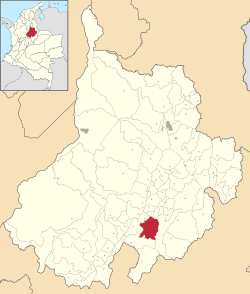Oiba facts for kids
Quick facts for kids
Oiba
|
|
|---|---|
|
Municipality and town
|
|
 |
|

Location of the municipality and town of Oiba in the Santander Department of Colombia
|
|
| Country | Colombia |
| Department | Santander Department |
| Province | Comunera Province |
| Founded | 28 February 1540 |
| Founded by | Martín Galeano |
| Area | |
| • Municipality and town | 287 km2 (111 sq mi) |
| • Urban | 3 km2 (1 sq mi) |
| Elevation | 1,420 m (4,660 ft) |
| Population
(2015)
|
|
| • Municipality and town | 11,738 |
| • Density | 40.90/km2 (105.93/sq mi) |
| • Urban | 5,547 |
| Time zone | UTC-5 (Colombia Standard Time) |
| Website | Official website: http://www.oiba-santander.gov.co/index.php/es/ |
Oiba (pronounced like OY-bah) is a small town and municipality in the Santander Department of northeastern Colombia. It is a beautiful place located in the mountains.
Oiba shares its borders with several other towns. To the north, it is next to Guapotá and Confines. To the east, you'll find Charalá. On the west side, it borders Guadalupe and Guapotá. Finally, to the south, it is close to Suaita.
The capital city of the Santander Department, Bucaramanga, is about 151 kilometers (94 miles) north of Oiba. Colombia's national capital, Bogotá, is about 270 kilometers (168 miles) to the south.
History of Oiba
Before the Spanish arrived, the area where Oiba is now was home to the Guane. They were an indigenous group living in this region of Colombia.
The modern town of Oiba was officially founded on February 28, 1540. It was established by a Spanish explorer named Martín Galeano. This marked the beginning of Oiba as a Spanish settlement.
What Oiba Produces
Oiba is mostly an agricultural community. This means that farming is a very important part of its economy. People in Oiba grow many different crops.
The main crops grown here include:
- Coffee: A popular drink around the world.
- Sugarcane: Used to make sugar.
- Maize: Also known as corn.
- Yuca: A root vegetable, also called cassava.
- Tree tomatoes: A fruit that grows on trees.
These crops help support the people living in Oiba and contribute to the local economy.
See also
 In Spanish: Oiba para niños
In Spanish: Oiba para niños

